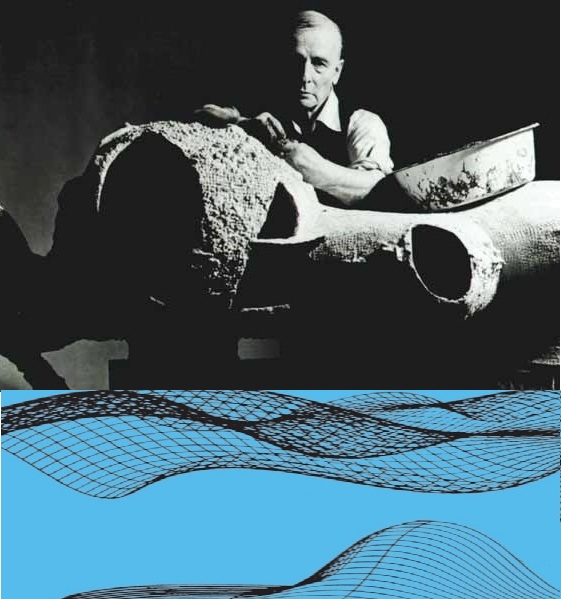
The form of the house is not amorphous, not a free for all form. On the contrary, its construction has strict boundaries according to the scale of your living. Its shape and form are determined by inherent life processes. —Frederick Kiesler.
Parametric design is not unfamiliar territory for architects. From ancient pyramids to contemporary institutions, buildings have been designed and constructed in relationship to a variety of changing forces, including climate, technology, use, character, setting, culture, and mood. The computer did not invent parametric design, nor did it redefine architecture or the profession; it did provide a valuable tool that has since enabled architects to design and construct innovative buildings with more exacting qualitative and quantitative conditions.
By the time of a conference held by the Boston Architectural Center in 1964, it had become clear that the electronic era would have a dramatic effect on building design. The aerospace industries were using computers to calculate complex warped surfaces and animated flight path simulations, which fascinated architects. [Opening image, bottom.] As UCLA student Raphael Roig predicted in his unpublished master’s thesis, The Continuous World of Frederick J. Kiesler, “It would only be a matter of time before computer technology would be able to reduce to constructible terms the inherent intricacies of forms similar to Kiesler’s multiple-warped surfaces.” [Opening image, top.] Kiesler and other artists and architects—including Antonio Gaudi, Erich Mendelsohn, Frei Otto, Kiesler, and Kiyonori Kikutake—had conceived and modeled complex structures and forms with varying degrees of technical proficiency, and Roig in the 1960s recognized that new computer technologies could assist their design and construction.
It was not, however, until the 1980s that breakthroughs in parametric design became useful to architects. Advances in the quasi-scientific field of plant and animal morphology supported innovation that could be applied with ingenuity to tectonic practices.
Nature had long since developed structural systems of nuanced complexity that architects and designers had applied to structure building shapes and urban organizational patterns. Louis Sullivan, Mies van der Rohe, Lazlo Moholy-Nagy, Sir Patrick Geddes, and others, were influenced by the morphological writings of Goethe (Metamorphosis of Plants, 1790), E.S. Russell (Form and Function, 1916), and R.H. Francé (Plants as Inventors, 1920). Yet, despite important analytical advances made in D’Arcy Thompson’s On Growth and Form of 1917 (revised 1942), alongside subsequent mathematical models for shaping biological patterns developed by Alan Turing in 1952 and Aristid Lindenmayer in 1968, morphology had become a sleepy science throughout the mid-twentieth-century. As with Kiesler’s flowing forms, it had proven too difficult to measure and draw with detailed accuracy the evolving structures and intricate patterns of organic life. But between Benoit Mandelbrot’s 1982 study in The Fractal Geometry of Nature and K. J. Falconer’s 1990 developments in fractal theory, the computer emerged as a tool for simulating the generation of biological forms (morphogenesis). Coral, sponges, and other simple marine and plant life developing and performing in response to a limited set of measurable criteria—light, ocean current, nutrition, etc.—could be analyzed and reconstructed using parametric design models in the computer. Applying similar morphological simulations in architecture, designers in the late 1980s to mid-1990s began to use the computer alongside software developed for aerospace and the moving picture industry to “animate form.”
Los Angeles architect Greg Lynn became the foremost theorist and designer to use the computer to generate what became his notorious “Blob” and “Fold” architecture. His book Animate Form (1999) studied the history and set the guidelines for architecture that could be calculably grown using genetic systems and codes—if only virtually in the computer. The “spline” proved most relevant for its simple and concise parametric capacity. It could be pushed, pulled, stretched, and manipulated in coordination with a set of data to produce a continuous curve that surmised an average of multiple vector information.
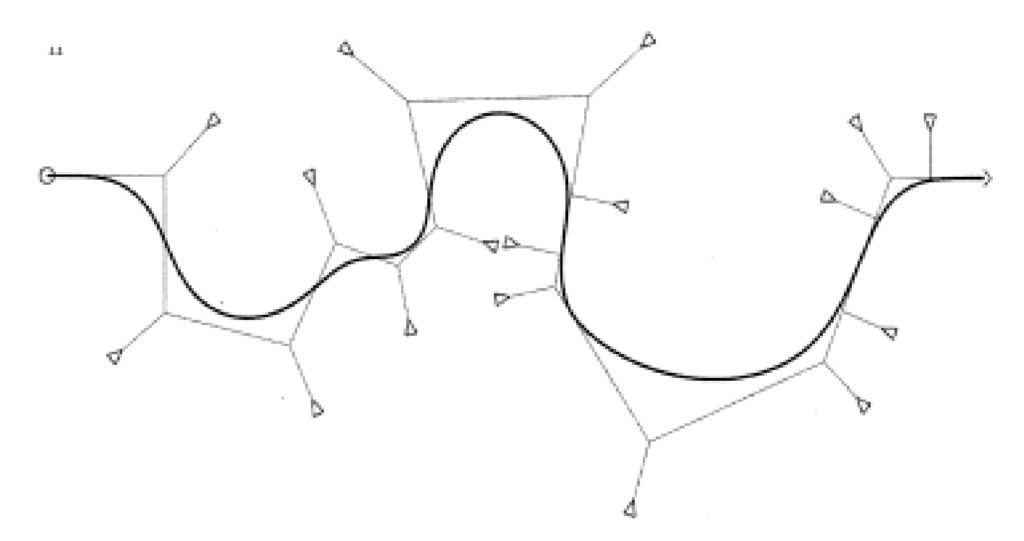
Ben van Berkel and Caroline Bos Studio published the 1995 “Rubber-Mat Project for Rotterdam, 2045,” which outlined how to use computational tools to conceive large urban infrastructures by inputting a range of parametric criteria—set to time and motion with animation software.
Peter Eisenman’s Musée Du Quai Branly project of 1999 provided the image of what might be possible using these design techniques, and UN Studio’s 1998 trilogy Move showcased an evolution of complex forms from design to construction, now possible using advanced CAD/CAM-CNC milling machinery alongside new rapid prototyping technology.
The limit to these parametric studies being pursued primarily by students and faculty at Columbia University, the Architectural Association, and other graduate schools—were the forms themselves, which appeared grossly inarticulate, undefined, and too difficult to construct. Besides Lynn and UN Studio, several architects began to deepen their research to engage a more detailed building scale: William Massie, Mark Burry, Mark Goulthorpe, Office dA, SHoP, Coop Himmelb(l)au, Asymptote, Jesse Reiser, Zaha Hadid, and Ocean North are only a few of the most original architects to pursue design and fabrication techniques that investigated ideas relevant to parametric systems.
The Architectural Association’s Design Research Laboratory (AADRL) and Emergent Technologies in Design (EmTech) programs were perhaps the center of international research and development on the subject. Yusuke Obushi, now at the AADRL, presented a remarkable thesis, “Wave Garden,” at Princeton University in 2002, embodying the principles of parametric design by creating an occupiable, energy-generating surface correlated to the movement of an ocean current.

Jason Payne and Heather Roberge of Gnuform invented a similar if more “hairy” installation in 2003 at Ohio State University, called Man-o-War.
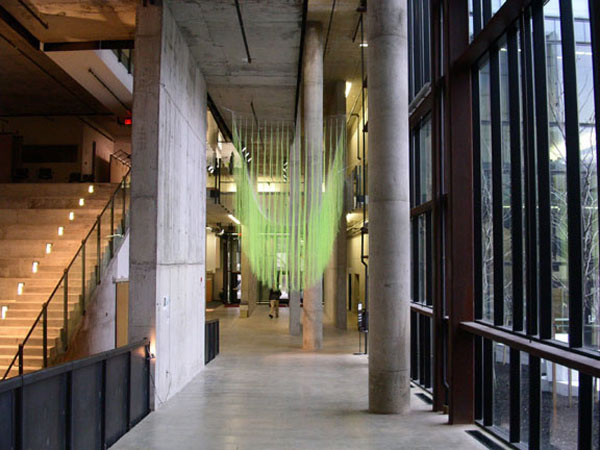
Michael Hensel of EmTech and Ocean North produced some of the most comprehensive texts on parametric systems and morphogenetic design practices in Architectural Design (AD)—a magazine that provided a rich forum for the most innovative developments of the past fifteen years. “Architecture and Animation,” “Versioning,” and “Morphogenetic Design” were among the more important editions of AD.
UN Studio’s UN Fold showed how parametric design could be advanced on an urban infrastructural scale. (Neil Leach, who contributed to UN Studio’s publication, would eventually develop similar urban growth strategies as a faculty member at USC.)
Perhaps most important, Foreign Office Architects (FOA) completed the Yokohama International Port Terminal in 2002, proving that complex building forms correlated to a series of imagined or perceived parameters could be organized and constructed on a grand scale with dynamic, real-world results.

California architects and educators consistently contributed strong, innovative leadership within this developing field. SCI-Arc and UCLA provided a rich environment to advance new computer and fabrication technology. Highlights of the work of their faculty include David Erdman and Marcelyn Gow of Servo’s “Lattice Archipelogics” lighting installation (2002); Marcelo Spina and Georgina Huljich of Patterns’s “Element” vacuformed installation (2005) and “Rooted Flow” large scale urban proposal (2005); Hernan Diaz Alonso’s evocative botanical images and structures; and Gnuform’s sensual NGTV floral bar (2005). With these design inventions emerged ample debate surrounding concepts of “beauty” versus the “grotesque,” as architects clamored to adjust their aesthetic sensibilities to the qualities and sensations inherent to these newly emerging, computer-designed images and forms.
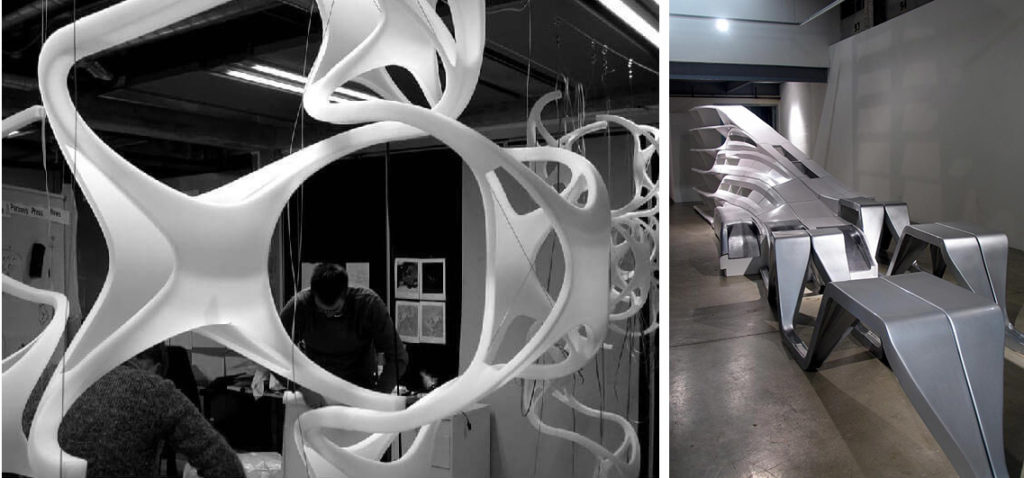

In the Bay Area, architects Lisa Iwamoto and Craig Scott developed the Jelly Fish House (2005), which aligned plant and animal morphology with detailed structural study of tessellated building systems and patterns, correlated parametrically to changes in building stress and strain.
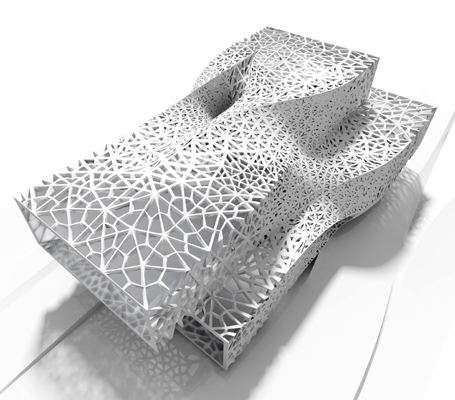
Hoping to make his designs similarly more constructible, Tom Wiscombe of Emergent Architecture in Los Angeles began to exploit D’Arcy Thompson’s studies of dragonfly wings to produce patterned, cantilevering spatial structures for his Paris Courthouse design (2006) and SCI-Arc gallery installation (2007). Benjamin Ball and Gaston Nogues’s of Ball Nogues Studio, in addition, produced the phenomenal “Maximilian’s Schell” (2005) out of a vortex of 504 parametrically fabricated, laminated mylar, petal-cut sheets.
Tessellated patterning systems soon became fundamental to structuring complex organic forms, and complementary aesthetic theories on ornament, decoration, and elegance began to dominate architectural discourses. Works and texts by Ali Rahim at PennDesign at the University of Pennsylvania and Alejandro Zaera-Polo and Farshid Moussavi of FOA, now respectively at Princeton University School of Architecture and the Harvard Graduate School of Design, fueled these discussions—alongside developments in computer programming and scripting to facilitate a wide range of detailed structural tiling and patterning sequences. Designers inspired by Stephen Wolfram’s formative programming research in A New Kind of Science and Mathematica developed a wide variety of “Voronoi-esque” tiling scripts to create varied ornamental structures and/or purely decorative, “skin deep” motifs. Thom Faulders of Faulders Studio and CCA captured this moment in history most succinctly in his screen façade for Studio M’s Airspace Tokyo of 2007. Benjamin Aranda and Chris Lasch described, developed, and published these scripting procedures in their Tooling (Pamphlet Architecture #27, 2006).


Ultimately, on the scale of constructability, Gehry Partners and Morphosis have proven to be the driving forces behind building innovation on the West Coast in the last twenty years. Investing in CAD/CAM technologies since 1989, Gehry proved that architects could take the lead not only in design, but also in managing the techniques of advanced building systems and their detailed construction. By 2002, Gehry and Partners created Gehry Technologies, a research and technology team committed to supporting advances in the field. The Guggenheim Museum Bilbao (1997) and the Walt Disney Concert Hall (2000) demonstrated how well these techniques could be implemented. Delivering the new Caltrans District 7 Headquarters (2004) to downtown LA in record speed, Thom Mayne and his team at Morphosis also proved it was possible for architects to design innovative, environmentally conditioned buildings that could be constructed more cost-effectively by working directly with manufactures and fabricators. The computer proved useful not only for design, modeling, and fabrication, but for construction administration, as well. Morphosis’s Phare Tower may very likely prove to be the most advanced building to date to use parametric design technology and fabrication processes to achieve built form.
Offshoots of these larger firms have made notable contributions to parametric design on a much smaller scale. Margaret Griffin and John Enright (formally of Morphosis) working with Dr. Anders Carlson—a structural engineer educated at Caltech—exploited CNC milling processes to invent and construct curvilinear plywood “I” joists to produce complex building structures. SPARCHS, working with Rogan Ferguson (formerly of Gehry and Partners), also alongside Carlson, investigated similar plywood CNC milled structures in addition to continuous tension shell technologies to build a series of roof planes correlated parametrically to shifting environmental conditions using Computer Aided Three-dimensional Interactive Application (CATIA) software for their Seadrift House (2004) [16, 17].

Herwig Baumgartner and Scott Uriu of B+U architects (both formerly of Gehry and Partners) developed innovative software for correlating varying parameters, from moving crowds to urban sounds, to inflect the patterns and shapes of their building designs in, for example, their Taipei Performing Arts Center competition entry (2008).
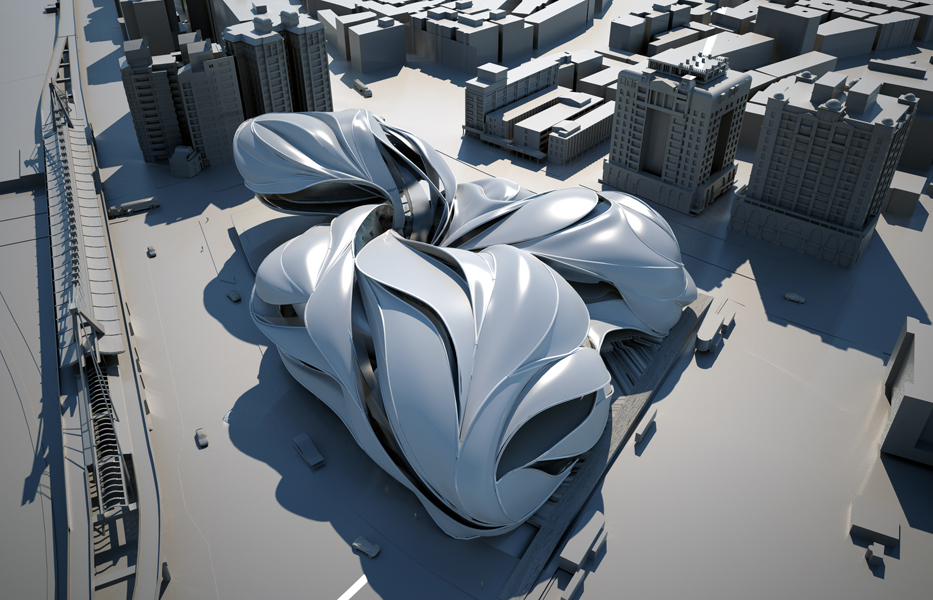
The speed at which the architecture profession has been developing within the field of parametric design has been phenomenal. Much of this success can be attributed to the synergy occurring over the past fifteen years between the schools—UCLA, SCI-Arc, UC Berkeley, Cal Poly, USC, and CCA, among others—educating students with the skills needed for experimental practice, and the vanguard firms.
Not everyone, however, is enamored by computer design or the promises of parametric systems. At the same conference at the BAC in 1965, Christopher Alexander, then an assistant professor at UC Berkeley, warned that architects might “fatally distort the nature of design by restating design problems solely for the purpose of using the computer.” He did not believe that there were design problems—environmental or architectural—so complex that they required a computer to solve, and he was not convinced that architects would not oversimplify design complexity to meet the limited input and operational capacities of their computers. The computer could not keep pace with the facility of human intuition for inventing architectural forms and deriving design solutions for complex problems.
Mathematical parametric and algorithmic procedures most often have proven far too rigid to productively engage the complex cultural, societal, economic, and political projects facing architects today. Designing buildings and cities using parametric and scripting design tools may often appear visually stunning, but for the most part these designs tend to incorporate far too many blind assumptions to be able to respond with nuance to real world situations.
Today, many leading designers who engaged in parametric design over the past ten to fifteen years would to some extent agree. Moving away from the delimiting input techniques used to derive building forms and urban topologies, the design vanguard has begun focusing more on the performative and affective qualities of architecture design and its practice.
Author Stephen Phillips, AIA, PhD, is a California architect, educator, and scholar. He is Assistant Professor of Design at Cal Poly San Luis Obispo and principal of Stephen Phillips Architects (SPARCHS). Phillips has published widely and has received awards, grants, and fellowships for his work from the Getty Research Institute, Graham Foundation, Smithsonian American Art Museum, Canadian Center for Architecture, AIA, ACSA/AIAS, among other institutions.
Originally published 4th quarter 2009 in arcCA 10.1, “Parametrics and IPD.”





